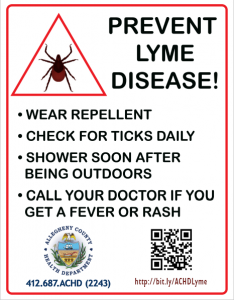May is Lyme Disease Awareness Month, Learn Tips and Tricks for Preventing Tick Bites and Lyme Disease

Did you know that Lyme Disease is the most common vector-borne illness in the United States? The Center for Disease Control and Prevention (CDC) estimates that over 300,000 people contract the disease every year with most cases occurring in the northeastern region of the country. The disease is caused by the bacterium Borrelia burgdorferi, which is transmitted by the blacklegged tick.
With some preparation, you can take steps to protect yourself, your family, and your pets from tick bites and Lyme Disease. Ticks are most active during the warmer months, and the chance of being bitten by a tick is greatest from May-September. Before going outdoors, know where to expect ticks and avoid those areas, pretreat clothing and gear, and use insect repellent. Ticks live in grassy, wooded areas. When walking through the woods, stay in the center of trails and avoid areas with high grass and leaf litter. Clothing and shoes can be treated with permethrin. Spraying clothes and shoes with permethrin can be one of the most effective techniques for preventing tick bites. Additionally, some insect repellents can help protect you from tick bites. Use the Environmental Protection Agency’s insect repellent search tool to find the right repellent for ticks.
Ticks can be carried into the house on clothing, gear, and pets. Check your clothing and gear and remove any ticks that are found. Shower soon after being outdoors. Consider drying clothes in a tumble dryer on high heat for 10 minutes which will kill ticks. It is essential to check your body for ticks after being outside. Conduct a full body check and remove any ticks within 24 hours if possible. Check the following parts of your body:
- Under the arms
- In and around the ears
- Inside belly button
- Behind the knees
- In and around the hair
- Between the legs
- Around the waist
Following these steps will ensure that you and your family are protected from tick bites while enjoying time outdoors. For more information about ticks and Lyme Disease from our ACHD vector-borne illness team, please visit: http://bit.ly/ACHDLyme.

